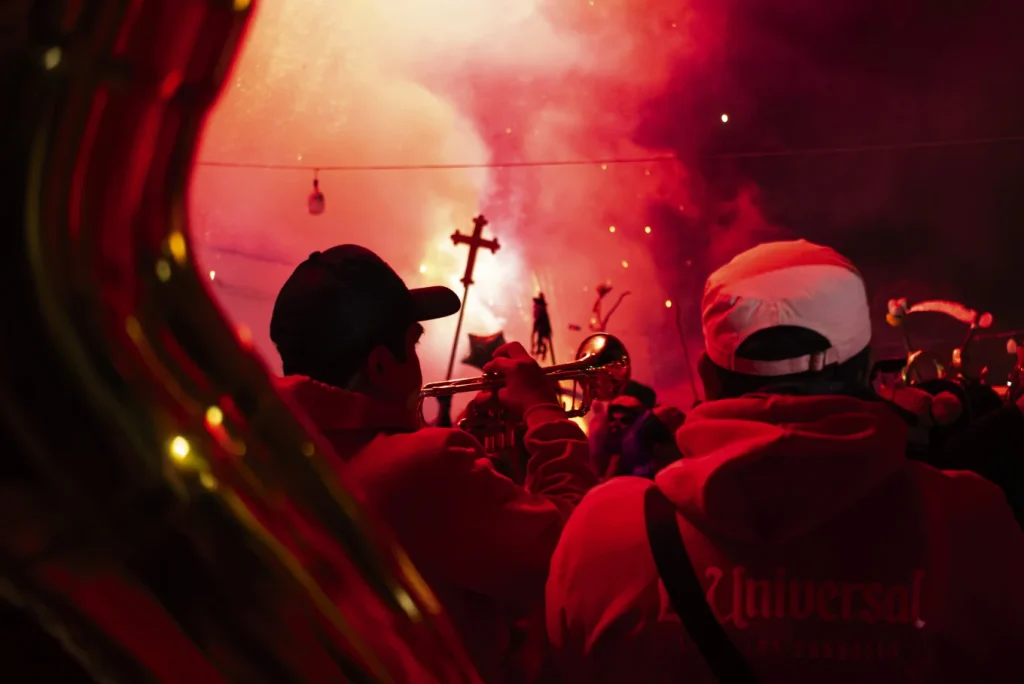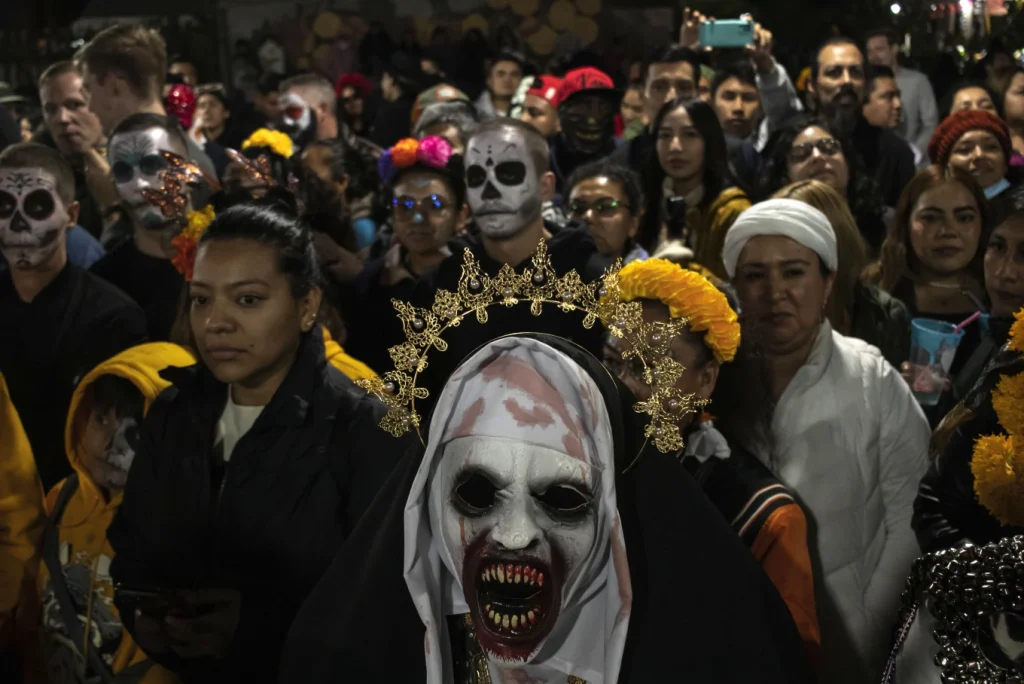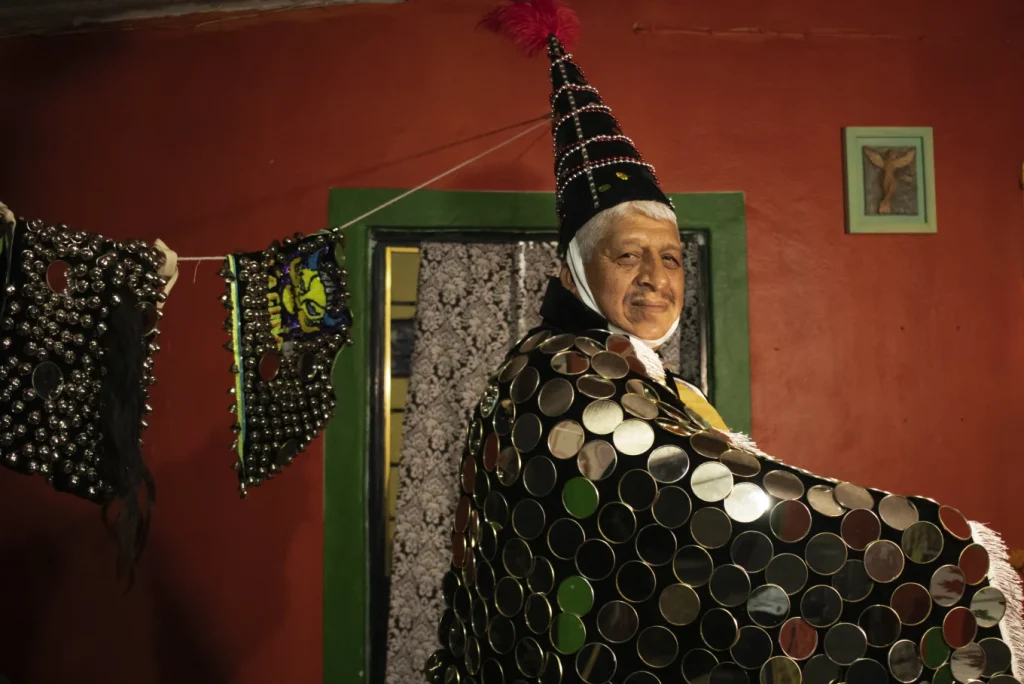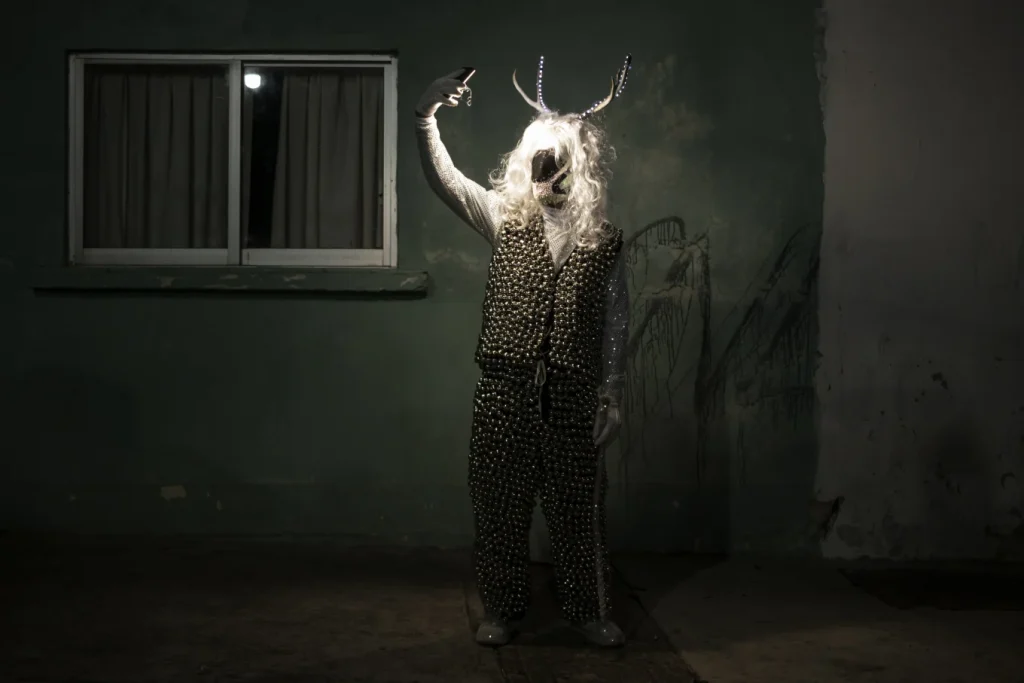Located in San Agustín Etla, Mexico, the vibrant and culturally rich region of Oaxaca comes alive during the Day of the Dead celebrations.
For Daniel Dávila, a 33-year-old resident, this annual event holds a special significance as he transforms into a devil, a role he has embraced since the tender age of 12.
Weeks before the festivities, Dávila meticulously prepares his costume, ensuring every detail is perfect. On November 1st, families from all walks of life gather in the streets of San Agustín Etla, commemorating the beauty of life and death.
Known as “muerteadas,” these celebrations are deeply rooted in the local identity and extend over several nights.
While each town may have its unique traditions, most muerteadas commence at the main church, where participants and musicians come together to sing in honor of their local saints.
Following this solemn ceremony, volunteers like Dávila engage in a mesmerizing theatrical performance. One character, known as a spiritist, possesses supernatural abilities and brings a deceased individual back to life, captivating the audience with their otherworldly powers.
The Day of the Dead celebrations in San Agustín Etla serve as a testament to the profound connection between life and death, reminding everyone of the joyous nature that can be found even in the face of mortality.
In the realm of dramatic literature, Dávila’s role as the devil in the play serves as a captivating and mischievous character, whose primary objective is to entice and seduce the resuscitated man into following his dark path.
This playful and cunning portrayal of the devil adds a layer of intrigue and suspense to the narrative, as the audience witnesses the constant battle between good and evil.
Alongside Dávila, there are other significant characters that contribute to the complexity of the story. The presence of a priest symbolizes the struggle between faith and temptation, as he tries to guide the resuscitated man towards redemption and salvation.
Additionally, a doctor’s inclusion highlights the medical aspect of the plot, as he grapples with the ethical implications of bringing someone back from the dead.
Lastly, an old man, whose daughter is married to the deceased, represents the emotional turmoil and familial ties that are at stake in this compelling tale.
Overall, the combination of these diverse characters creates a rich tapestry of human nature, morality, and the eternal battle between light and darkness.
“I have been participating in muerteadas since I was in kindergarten,” Dávila stated, a sense of pride evident in his voice as he gestured towards the devil suit he had meticulously crafted.
The suit was adorned with dozens of sleigh bells, each one carefully sewn onto the fabric. “I love being a part of this tradition because it has been passed down through generations in my family.”
The staging of muerteadas, with its unique blend of humor and satire, never fails to captivate both participants and spectators alike. All the characters involved speak in verses, and their dialogues are often filled with the latest gossip and political commentary from the community.
While there is a script to guide the actors, improvisation is not only encouraged but expected, adding an element of spontaneity and excitement to the performances.
After the curtains close and the final act of the performance comes to an end, there is a sense of relief and jubilation in the air.
To commemorate the triumph of life over adversity, the night continues with a lively procession, led by a vibrant band.
The streets come alive with the infectious rhythm of the music, as people from all walks of life join in the festivities.
Laughter and merriment fill the air, as individuals come together to celebrate the resilience and tenacity of the human spirit.
The celebration spills into the homes of neighbors, as friends and acquaintances open their doors to welcome one another with open arms.
The sound of clinking glasses and joyful conversations reverberate through the night, further enhancing the sense of camaraderie and togetherness.
Amidst the revelry, the traditional drink of mezcal flows freely, adding an extra layer of warmth and cheer to the occasion.
The night seems to stretch on endlessly, as the community revels in the collective joy and shared sense of accomplishment.
However, as the night progresses, the celebration gradually begins to fade, making way for a more somber and reflective atmosphere.
The procession eventually reaches its destination, the cemetery, where the festivities draw to a close. It is here, in the presence of the departed, that the revelers take a moment to pay their respects and reflect on the transient nature of life.

As the first rays of sunlight begin to peek over the horizon, the once vibrant and bustling streets grow quiet, as the community disperses, carrying with them memories of a night filled with joy, laughter, and a profound appreciation for the resilience of the human spirit.
The tradition of muerteadas is a unique and significant aspect of Mexican culture, celebrated with great enthusiasm and fervor by the local communities.
As stated by Dávila, this special time is not just about dances and drinking, but rather a time for sharing what brings us joy.
It is a time for the community to come together, to celebrate and honor their ancestors, and to pay tribute to the cycle of life and death.
The origins of muerteadas can be traced back to ancient times, when entire families would lead processions wearing jaguar masks.
This practice, which has evolved over time, has become an integral part of the cultural heritage of Mexico, and is celebrated with great pride and reverence by the local people.
The muerteadas are a testament to the rich and diverse cultural heritage of Mexico, and serve as a reminder of the importance of honoring our ancestors and preserving our traditions for future generations.
Efraín García, a 57-year-old resident of the neighboring town of San José Etla, is preparing for this year’s muerteadas by dressing up as the spiritist.
His costume is an impressive cloak adorned with 800 mirrors, meticulously sewn over the course of a week. The weight of this intricate creation is approximately 70 pounds, a testament to García’s dedication and craftsmanship.
As he dons his elaborate attire, García reflects on the significance of this tradition. “We celebrate this occasion to honor our dearly departed, as it was something they enjoyed,” he explains.
Not only does García partake in the festivities himself, but his children also contribute by crafting costumes for others to purchase.
Despite the inherent sadness associated with remembering lost loved ones, the community finds solace and joy in carrying on with these celebrations.
They firmly believe that the spirits of their departed relatives are present with them during these special days.
The meticulous planning and preparation that go into organizing the annual festivities are a testament to the dedication and commitment of the organizers.
Horacio Dávila, who happens to be Daniel’s cousin, shed some light on the behind-the-scenes efforts that begin as soon as the current year’s celebration draws to a close.
It is truly remarkable that even before the winter frost has settled, the organizers are already on the lookout for a music band that will perfectly complement the vibrant and lively atmosphere of the muerteadas.
December marks the starting point of this arduous task, as they meticulously scour through a myriad of options, carefully considering each band’s style, repertoire, and ability to captivate the hearts and souls of the attendees.

This early commitment to securing an exceptional musical act speaks volumes about the organizers’ unwavering dedication to ensuring that each subsequent year surpasses the previous one in terms of entertainment and overall experience.
According to Dávila, this event is not inexpensive. In certain towns, individuals are required to pay a fee in order to portray a character during the theatrical representation, and it is expected that neighbors will contribute towards hiring the band.
The cost of devil and spiritist costumes can even reach up to 800 U.S. dollars. However, despite the financial burden, Dávila emphasizes that this event is deeply rooted in tradition and is eagerly anticipated by most locals.
He explains that Mexicans have a tendency to handle difficult situations with humor and mockery, turning adversity into a source of amusement.
Dávila even humorously states that when he passes away, he encourages people not to mourn for him, but instead to celebrate with music and be grateful that he is finally at rest.
The Associated Press has been a leading source of news and information for decades, covering a wide range of topics and issues that affect people around the world.
One area of coverage that has received significant support in recent years is religion, thanks to the AP’s collaboration with The Conversation US and funding from Lilly Endowment Inc.
This partnership has helped to ensure that the AP’s religion coverage remains robust and informative, providing readers with in-depth analysis and reporting on the latest developments in this important area.
While the AP is solely responsible for the content it produces, the support of The Conversation US and Lilly Endowment Inc. has been instrumental in helping to make this coverage possible.
As the world continues to grapple with complex issues related to religion and faith, the AP’s coverage will remain an essential resource for those seeking to stay informed and engaged.
I would like to take a moment to express my appreciation for the Associated Press (AP) and its commitment to providing comprehensive and insightful coverage of religion.
The AP has long been recognized as a trusted source of news and information, and its collaboration with The Conversation US, funded by the Lilly Endowment Inc., further enhances its ability to deliver high-quality reporting in the field of religion.
The collaboration between the AP and The Conversation US is a testament to the importance of partnerships and the power of collective efforts in journalism.
By joining forces, these two esteemed organizations are able to pool their resources, expertise, and networks to produce religion coverage that is not only accurate and reliable but also thought-provoking and engaging.
The funding from Lilly Endowment Inc. is instrumental in supporting the AP’s religion coverage. As one of the largest private foundations in the United States, Lilly Endowment Inc. has a long-standing commitment to promoting excellence in religious journalism.
Its financial support allows the AP to dedicate the necessary resources and manpower to cover a wide range of religious topics, from the latest developments in major world religions to the exploration of lesser-known faith traditions.
It is worth noting that the AP takes full responsibility for the content it produces in collaboration with The Conversation US.
This level of accountability is crucial in maintaining the AP’s reputation for journalistic integrity and unbiased reporting.
By assuming complete ownership of the content, the AP ensures that its audience can trust the information presented, knowing that it has undergone rigorous fact-checking and adheres to the highest ethical standards.
Religion is a complex and multifaceted subject, with significant implications for individuals, societies, and global affairs.

The AP’s commitment to providing comprehensive religion coverage reflects its understanding of the importance of religion as a social and cultural force.
By reporting on religious matters, the AP contributes to a more informed public discourse, fostering greater understanding and dialogue among diverse communities.
In conclusion, the collaboration between the AP and The Conversation US, supported by Lilly Endowment Inc., represents a significant milestone in the field of religion journalism.
The AP’s dedication to delivering accurate, reliable, and engaging religion coverage is commendable, and its partnership with The Conversation US allows for a wider reach and greater impact.
As consumers of news and information, we are fortunate to have access to such high-quality reporting, which enriches our understanding of the world and the role of religion within it.
